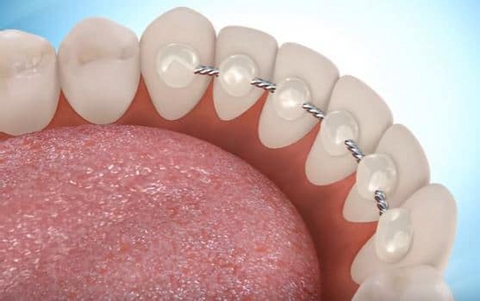Once orthodontic treatment has been completed, the use of retainers after braces is a very important part of the continuing maintenance of teeth and will go a long way toward keeping the same bite and smile that the braces formed over the previous few years.
 Your retainer sits inside your mouth and against your teeth, so it quickly accumulates bacteria, plaque, and tartar. Just like you brush your teeth every day, it’s essential to clean your retainer every day. So, you might be wondering how to care for it.
Your retainer sits inside your mouth and against your teeth, so it quickly accumulates bacteria, plaque, and tartar. Just like you brush your teeth every day, it’s essential to clean your retainer every day. So, you might be wondering how to care for it.
In this article, we will help you know more about the different types of retainers, how to clean them.
1. Fixed or bonded retainers
These are usually called permanent retainers. Fixed retainers are a thin wire worn across the back of the lower or upper front teeth, which is bonded in place with a cement similar to that applied on the brackets of braces. They’re used if you have a high risk of having your teeth shift. You can’t remove this type of retainer. It’s usually put into place for months or even years.

How to clean it?
A floss threader or similar cleaning device must be used to access the interproximal spaces between the teeth, which is similar to how people with braces have to floss.
- Grab a 6-inch piece of floss and use a floss threader to thread the floss between your two front lower teeth.
- Hold one end of the floss with your fingers and the other with the threader.
- Once you get the floss under your retainer wire, simply move it up and down between the teeth all the way to the gum line. The floss should gently go below the gum line if possible.
- Slide the floss sideways to the next area you want to clean. Pull down until it’s between your teeth.
- Repeat this process with each tooth that’s attached to your permanent retainer.
2. Hawley and Clear Plastic retainers
Hawley is the most well-known removable retainer type. It consists of a metal wire which surrounds the six anterior teeth and incorporated with two omega loops for adjustments. The wire is anchored on an acrylic baseplate that sits on the roof of the mouth.

On the other hand, clear plastic retainers slip over your teeth and are pretty much invisible. It is a clear or transparent retainer that is fitted to the whole teeth curve or from canine to canine only. It is produced from a mold and looked like an Invisalign tray. It also only recommended being worn at night.

Compared to Hawley, clear plastic retainer is cheaper, less visible, and easier to wear.
How to take care of them?
Since it is removable, this type of retainer makes it easier to clean your teeth, but the patient has to remember to wear it daily. Initially, your orthodontist or dentist will want you to wear it all day and all night for at least three months; if no movement is detected, you may be instructed to wear the retainer only at night or for a few hours in the daytime.
- Avoid heat. Exposing this type of retainer to high heat can warp and ruin it.
- Skip the chemicals. Researchers discovered that using chemical cleaning tablets didn’t reduce the number of bacteria any more than simple brushing did.
- Time your soak. Only soak the retainer for the time it takes to clean it, or as specified on your cleaning tablets.
- Clean your case. Try cleaning it once a day before you put your retainer away. Gently scrub all surfaces pf it in warm, soapy water. Then rinse it off and pat to dry.
- Replace as needed. Retainers are somewhat like contact lenses or shoes: They’re subject to daily wear and tear. Contact your orthodontist if you notice that your retainer is particularly dirty, worn out, or no longer fits properly.
Other notes:
Brushing the retainer is good, but it is also recommended to soak it in a retainer cleaner daily to remove the bacteria that might have been missed by brushing.
Also, be wary of the cleaning agent you use. Ensure that the product is not abrasive as it can damage the retainer. If calcium deposits remain stuck to the retainer after brushing or soaking it, you should consult your orthodontist to help you address the issue.

